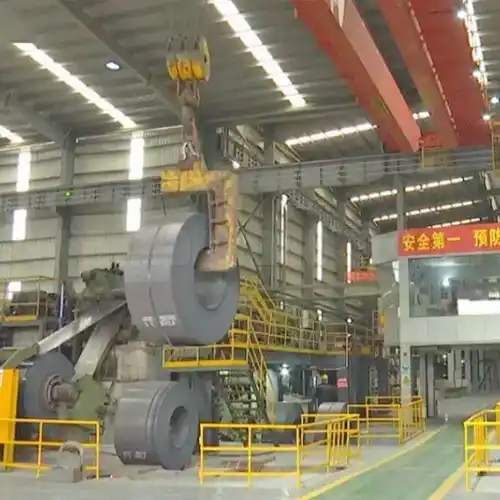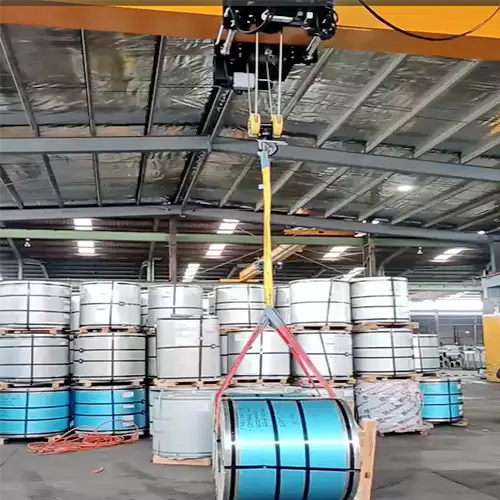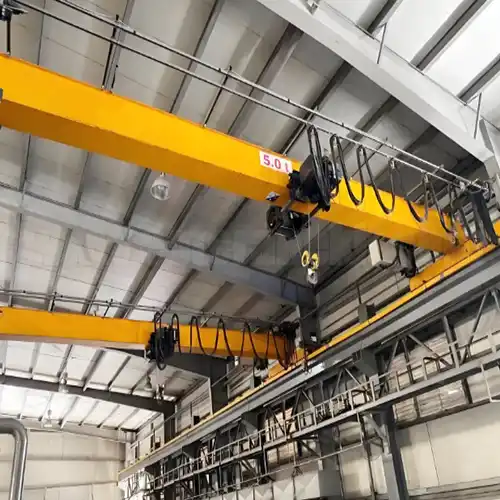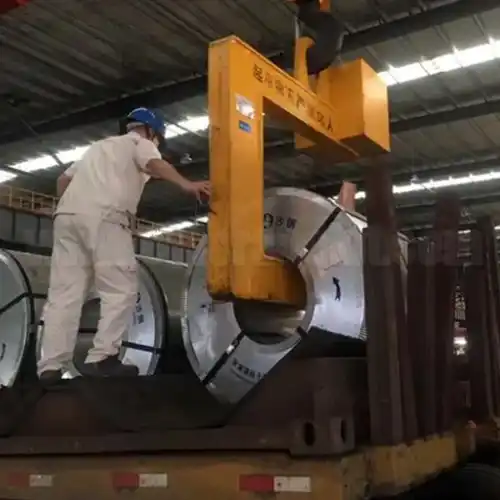Coil Handling C-Hook Cranes 5 ton, 10 ton, 16 ton, 25 ton, 32 ton
C hook crane for sale. C-Hook Cranes efficiently handle heavy coils, providing secure lifting, precise control & versatility for industrial applications.
Category: Coil Handling
Your Trusted C Hook Crane Manufacturer & Supplier
Coil Handling C-Hook Cranes 5 Ton, 10 Ton, 16 Ton, 25 Ton, 32 Ton
C hook crane for sale. C-Hook Cranes efficiently handle heavy coils, providing secure lifting, precise control & versatility for industrial applications.
Coil Handling C-Hook Cranes: 5 Ton, 10 Ton, 16 Ton, 25 Ton, 32 Ton
Coil handling C-Hook cranes are specialized lifting solutions designed to efficiently and safely manage the handling of coils across various industries. Available in a range of capacities—5 ton, 10 ton, 16 ton, 25 ton, and 32 ton—these cranes are engineered to meet the specific demands of different industrial applications, from light manufacturing to heavy-duty metal processing.
These cranes are particularly valued for their versatility and precision. Each capacity level is tailored to handle specific load requirements, ensuring that operations run smoothly whether dealing with small coils in compact spaces or managing large, heavy coils in expansive industrial environments. The robust design of C-Hook cranes, combined with advanced safety features, allows for reliable performance, minimizing risks and enhancing productivity across all levels of coil handling tasks.
Whether in automotive manufacturing, steel processing, or general warehousing, C-Hook cranes provide the ideal solution for efficient and safe coil management, making them an essential tool in industries where precise and secure handling of coiled materials is critical.
Introduction to C-Hook Cranes
C-Hook cranes are specialized lifting devices designed to handle and transport heavy and bulky loads, particularly those in the form of coils, rolls, or large materials with a circular opening. The "C" shape of the hook allows it to easily slide into the central opening of these loads, securely lifting and moving them with precision.
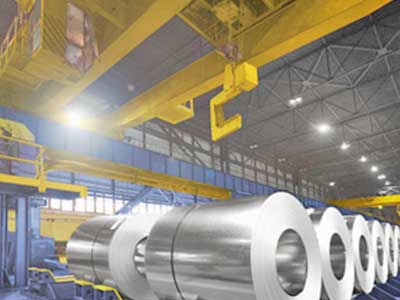
Overhead C Hook Cranes: These cranes are mounted on overhead runways, making them ideal for facilities where floor space is at a premium. They offer efficient vertical lifting and are widely used in environments where repetitive, high-capacity lifting is required, such as in steel mills, warehouses, and manufacturing plants.
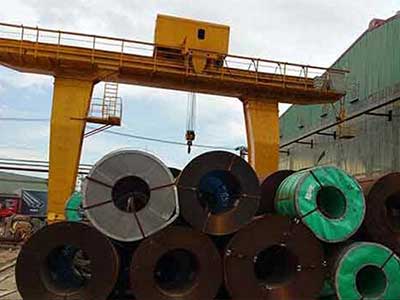
C-Hook Gantry Cranes: These cranes are similar to overhead cranes but are supported by legs that move on ground-level rails or wheels. They are particularly suited for outdoor use or in facilities where overhead space is limited. Gantry cranes with C-Hooks provide flexibility in handling loads in open yards, shipping docks, or assembly lines.
Importance in Industrial Settings
C-Hook cranes play a crucial role in industrial settings due to their ability to handle heavy and irregularly shaped loads that are difficult to lift with traditional hooks or slings. They are specifically designed for industries where large coils of steel, wire, or other materials are common, ensuring safe and efficient material handling.
Benefits for Heavy and Bulk Loads:
- Efficient Handling: C-Hook cranes streamline the process of moving large, heavy loads, reducing the need for multiple handling equipment and minimizing downtime. This efficiency translates into cost savings and improved productivity for industrial operations.
- Enhanced Safety: The design of the C-Hook ensures that loads are securely held during transport, reducing the risk of accidents or damage to the materials being handled. This safety aspect is particularly important in industries dealing with heavy, high-value materials.
Key Industries and Applications:
- Steel Mills and Metal Processing: C-Hook cranes are essential for handling large coils of steel or other metals. They allow for precise placement and transport of these materials during various stages of processing.
- Paper and Pulp Industry: In facilities where large rolls of paper need to be moved, C-Hook cranes provide a reliable solution for lifting and positioning these bulky items without damaging them.
- Warehousing and Logistics: In distribution centers and warehouses, C-Hook cranes are used to move heavy loads such as reels of cable or rolls of fabric, optimizing space and improving operational efficiency.
- Manufacturing: Industries that produce large components or need to handle materials like pipes or bars rely on C-Hook cranes to ensure smooth workflow and safe handling of these cumbersome items.
C-Hook cranes are a critical component in many industrial environments, offering a specialized solution for handling challenging loads. Their design and application make them indispensable in industries that require both precision and power in material handling.
Overview of Overhead C Hook Cranes
Overhead C Hook Cranes are specialized lifting systems equipped with a C-shaped hook, designed for handling loads like coils, spools, or other cylindrical objects. The unique shape of the C-Hook allows it to easily slide into the central opening of these loads, ensuring secure lifting and precise positioning. Overhead cranes with C-Hooks are installed on runways above the working area, providing an efficient method to transport heavy loads across large distances within a facility.
Key Features and Benefits:
- Efficient Load Handling: The C-Hook's design enables easy and quick engagement with loads, reducing handling time and increasing productivity. This is especially beneficial in environments where rapid and repetitive lifting is required.
- Space Utilization: Being mounted overhead, these cranes free up valuable floor space, allowing for more flexible use of the facility and improving overall workflow.
- Enhanced Safety: The secure grip of the C-Hook minimizes the risk of load slippage or accidents, which is crucial when handling heavy or expensive materials.
- Versatility: Overhead C Hook Cranes can handle a variety of load types and sizes, making them adaptable to different industrial needs, from steel mills to warehouses.
Types and Configurations
Single Girder vs. Double Girder Overhead Cranes:

Single Girder C-Hook Cranes: These cranes have one main girder and are generally more economical and easier to install. They are suitable for lighter loads, typically ranging from 10 to 20 tons. Single girder cranes are ideal for smaller facilities where space and budget constraints are a consideration.

Double Girder C-Hook Cranes: Featuring two main girders, these cranes offer higher load capacities, typically ranging from 20 to 100 tons or more. Double girder cranes provide greater stability and can accommodate larger spans, making them suitable for heavy-duty applications in large industrial facilities.
Design and Functionality
Structural Design Considerations:
- Material and Construction: Overhead C Hook Cranes are typically constructed from high-strength steel to ensure durability and long service life, even under heavy loads. The structural design is engineered to minimize deflection and ensure precise load handling.
- Load Distribution: The design of the crane's girders and the C-Hook ensures even distribution of load stress, reducing wear and tear on the crane and extending its operational lifespan.
Hot Sale Capacities for C-Hook Cranes:
C-Hook cranes are available in various capacities, each tailored to meet specific industrial needs. The following are the most sought-after capacities, providing versatile solutions for efficient and safe coil handling across different sectors:
5 Ton C-Hook Cranes:
- Design and Applications: Compact and efficient, these cranes are ideal for small to medium-sized coil handling tasks in warehouses and smaller manufacturing facilities. They are designed for precise control and maneuverability in confined spaces.
- Key Features: Lightweight construction with robust performance, ensuring safety and reliability. Suitable for frequent use in environments where space and load requirements are moderate.
10 Ton C-Hook Cranes:
- Design and Applications: Suitable for medium-duty tasks, these cranes handle larger coils with ease and are commonly used in automotive parts manufacturing, moderate steel processing, and general industrial applications.
- Key Features: Enhanced load stability and more powerful lifting mechanisms compared to 5-ton models. These cranes offer a balance between capacity and flexibility, making them a popular choice for diverse industries.
16 Ton C-Hook Cranes:
- Design and Applications: A versatile option for heavier coil handling, 16-ton cranes are used in large manufacturing plants and steel mills where higher load capacities are essential. These cranes are well-suited for demanding tasks that require robust and reliable equipment.
- Key Features: Superior load control and stability, with advanced safety features to handle the increased weight. Often equipped with automated controls for precision and efficiency in high-capacity environments.
25 Ton C-Hook Cranes:
- Design and Applications: These cranes are designed for heavy-duty applications, particularly in large-scale manufacturing and metal production facilities. They are capable of handling substantial loads, including large coils used in steel processing and shipbuilding.
- Key Features: Heavy-duty construction with reinforced materials to support the increased load. Equipped with advanced safety systems and ergonomic controls, these cranes are built for durability and long-term use in challenging environments.
32 Ton C-Hook Cranes:
- Design and Applications: The largest of the commonly used C-Hook cranes, 32-ton models are employed in the most demanding industrial settings, such as large steel mills, shipyards, and heavy machinery production lines. These cranes are engineered for maximum efficiency and load-bearing capacity.
- Key Features: Exceptional strength and stability, with cutting-edge technology to manage large-scale operations. These cranes often include specialized features like load sensors, automatic positioning systems, and high-precision controls to ensure safe and efficient handling of the heaviest coils.
These hot sale capacities offer tailored solutions for a wide range of industrial needs, ensuring that every task, from light to heavy-duty coil handling, is performed with maximum efficiency and safety.
Control Systems and Automation:
- Manual Control: Traditional systems rely on operator controls, allowing for precise manual adjustment of the crane's movement. This is suitable for applications where flexibility and human oversight are required.
- Automated Control: Modern Overhead C Hook Cranes often feature automated systems, including programmable logic controllers (PLCs) and remote controls. These systems enhance efficiency by reducing the need for manual intervention and allow for pre-programmed load movements, increasing operational speed and accuracy.
- Safety Integration: Advanced control systems also include safety features like load monitoring, anti-sway technology, and emergency stop functions, ensuring safe operation even in complex industrial environments.
Load Handling Specifications
Typical Load Capacities (10 to 100 Tons): Overhead C Hook Cranes are engineered to handle a wide range of load capacities, typically from 10 to 100 tons. The specific capacity of a crane is determined by its design, structural integrity, and the type of C-Hook used.
- 10 to 20 Tons: These cranes are often used in smaller facilities or for lighter materials, such as aluminum coils or smaller steel rolls. They offer precision handling for lighter loads and are commonly found in manufacturing plants and warehouses.
- 20 to 50 Tons: Medium-capacity C-Hook cranes are versatile and can handle a broad spectrum of industrial materials, including large steel coils, paper rolls, or heavy-duty wire spools. They are ideal for medium-sized operations in industries like automotive manufacturing and metal processing.
- 50 to 100 Tons: High-capacity C-Hook cranes are designed for heavy-duty industrial applications, such as steel mills, shipyards, and large-scale logistics operations. These cranes handle the heaviest loads with ease, ensuring efficient and safe material handling in demanding environments.
Performance Metrics and Efficiency:
- Lifting Speed: The lifting speed of Overhead C Hook Cranes varies depending on the load capacity and operational requirements. Higher speeds are typically achieved with lighter loads, while heavy loads may require slower, more controlled lifting to ensure safety and precision.
- Operational Efficiency: C-Hook cranes are designed to maximize operational efficiency by reducing the time and effort required to handle large, cumbersome loads. The combination of high load capacity and precise control mechanisms enables faster material handling, leading to increased productivity in industrial settings.
- Durability and Reliability: Built from robust materials, Overhead C Hook Cranes offer long-term durability, even under constant heavy use. Their reliability ensures minimal downtime, contributing to the overall efficiency of industrial operations.
Customization Options
Adjustable C-Hook Designs: Overhead C Hook Cranes can be customized with adjustable hooks to accommodate different load sizes and shapes.
- Adjustable Width: Some C-Hooks are designed with adjustable arms that can expand or contract to fit varying load widths, providing flexibility in handling different materials with the same crane.
- Height Adjustment: Certain C-Hook designs allow for height adjustments, enabling the crane to handle loads of different heights without compromising on safety or efficiency.
Specialized Load Handling Attachments: Beyond the standard C-Hook, cranes can be equipped with specialized attachments to handle unique or challenging loads.
- Rotating Hooks: A rotating C-Hook can be particularly useful in operations where loads need to be turned or rotated during transport, offering greater control and precision.
- Custom Grippers: In some cases, custom grippers or clamps can be integrated into the C-Hook design to handle irregularly shaped or delicate loads, such as glass panels or finished metal products.
These customization options allow Overhead C Hook Cranes to be tailored to the specific needs of an operation, enhancing their versatility and effectiveness in various industrial applications.
Safety and Compliance
Safety Standards and Regulations: Overhead C Hook Cranes must adhere to strict safety standards and regulations to ensure secure operations. Compliance with international and local safety standards, such as OSHA (Occupational Safety and Health Administration) regulations, is mandatory.
- Load Testing: Regular load testing is required to verify that the crane can safely handle its maximum rated capacity. This testing ensures the structural integrity of the crane and the C-Hook, preventing accidents due to overloading.
- Inspections and Certifications: Routine inspections by certified professionals are necessary to identify potential issues before they become critical. These inspections must be documented, and the crane must be recertified periodically to remain in compliance with safety regulations.
- Emergency Stop and Overload Protection: C-Hook cranes are equipped with emergency stop buttons and overload protection systems. These features automatically halt crane operations if the load exceeds the safe capacity, preventing equipment damage and accidents.
Safety Features and Best Practices:
- Anti-Sway Technology: This feature minimizes the sway of loads during movement, enhancing control and reducing the risk of collisions with other objects or people.
- Remote Control Operation: Remote control systems allow operators to control the crane from a safe distance, reducing the risk of injury in hazardous environments.
- Regular Safety Drills: Conducting regular safety drills ensures that operators are familiar with emergency procedures, including how to respond to equipment malfunctions or load failures.
Installation and Training
Installation Guidelines: Proper installation of Overhead C Hook Cranes is crucial for their safe and efficient operation.
- Site Assessment: Before installation, a thorough site assessment is conducted to determine the best placement of the crane, considering factors such as load distribution, building structure, and workflow efficiency.
- Foundation and Structural Support: The crane must be mounted on a solid foundation or integrated into the building's structure to ensure stability. Engineers must calculate the required support based on the crane's load capacity and operational demands.
- Electrical and Control Systems: Proper installation of electrical wiring and control systems is essential for smooth crane operation. This includes ensuring that power supplies are sufficient and that control panels are accessible and user-friendly.
Operator Training and Certification: Effective operator training is essential to ensure safe and efficient crane operation.
- Comprehensive Training Programs: Operators must undergo comprehensive training programs that cover all aspects of crane operation, including load handling, safety protocols, and emergency procedures.
- Certification Requirements: Operators should be certified by recognized authorities, ensuring they possess the necessary skills and knowledge to operate the crane safely. Certification is often required by law and must be renewed periodically.
- Ongoing Training: Continuous training programs help operators stay updated on the latest safety practices and technological advancements, ensuring ongoing compliance and optimal performance.
Maintenance and Upgrades
Routine Maintenance Best Practices: Regular maintenance is key to extending the lifespan of Overhead C Hook Cranes and ensuring their reliable performance.
- Scheduled Inspections: Routine inspections should be scheduled to check for wear and tear on critical components, such as cables, hooks, and control systems. Any worn or damaged parts should be replaced immediately.
- Lubrication and Cleaning: Regular lubrication of moving parts and thorough cleaning of the crane's components help prevent rust and corrosion, particularly in harsh industrial environments.
- Record Keeping: Maintaining detailed records of all maintenance activities ensures that the crane's history is well-documented, which is crucial for compliance and future reference.
Upgrading Systems for Enhanced Performance: As technology advances, upgrading Overhead C Hook Cranes can significantly improve their efficiency and safety.
- Control System Upgrades: Upgrading to more advanced control systems, such as those with automated or remote-control capabilities, can enhance operational efficiency and precision.
- Load Monitoring Systems: Installing load monitoring systems that provide real-time data on load weight and distribution can help prevent overloading and improve safety.
- Retrofitting with Advanced Safety Features: Older cranes can be retrofitted with modern safety features, such as anti-sway technology or improved emergency stop systems, to meet current safety standards and extend their service life.
By following these guidelines for safety, installation, training, and maintenance, Overhead C Hook Cranes can operate at peak efficiency while minimizing risks and ensuring compliance with industry standards.
Industry-Specific Applications
Automotive Industry: Overhead C Hook Cranes play a vital role in the automotive industry, where they are used to handle heavy components such as engines, chassis, and large body panels.
- Engine Assembly Lines: These cranes are essential for lifting and precisely placing heavy engine blocks during assembly, ensuring efficiency and reducing manual labor.
- Chassis and Body Panel Handling: Overhead C Hook Cranes enable the safe and efficient movement of large, cumbersome chassis and body panels through various stages of production, from welding to painting.
- Customization for Automotive Needs: In the automotive sector, C-Hook cranes are often customized with features such as adjustable hooks and specialized attachments to handle unique loads like vehicle frames or other non-standard parts.
Aerospace Industry: In the aerospace industry, the handling of large and delicate components such as aircraft wings, fuselages, and engines requires the precision and strength that Overhead C Hook Cranes provide.
- Aircraft Component Assembly: C-Hook cranes are used to lift and position large components like wings and fuselage sections during assembly, ensuring alignment and safety.
- Engine Maintenance and Repair: These cranes are also crucial in maintenance facilities, where they handle the removal and installation of aircraft engines, which require precise maneuvering due to their weight and size.
- High Precision Requirements: Aerospace applications demand cranes with advanced control systems to ensure the precise positioning of components, reducing the risk of damage and ensuring adherence to tight tolerances.
Overview of Gantry C-Hook Cranes
Definition and Function: Gantry C-Hook Cranes are specialized lifting systems designed to handle heavy and bulky loads in industrial environments. Unlike overhead cranes, gantry cranes are supported by legs that move along rails or wheels on the ground, providing flexibility in outdoor and large indoor spaces.
- Primary Function: The main function of a C-Hook gantry crane is to lift, transport, and position large and irregularly shaped loads, such as coils, pipes, and other heavy materials, using a C-shaped hook attachment. This hook is specifically designed to grip and hold cylindrical or rounded loads securely during transit.
- Versatility: These cranes are commonly used in environments where space and movement flexibility are crucial. They can be deployed in open yards, factories, or near loading docks, making them ideal for various industrial sectors.
Key Features and Benefits: Gantry C-Hook Cranes offer several features that make them highly effective for specific material handling tasks.
- Mobility: Unlike fixed overhead cranes, gantry cranes can be easily moved to different locations within a facility or yard, providing greater operational flexibility.
- Adjustable Heights: Many Gantry C-Hook Cranes come with adjustable height options, allowing them to handle loads at various elevations, making them suitable for different types of materials and operations.
- Ease of Installation: Gantry cranes are often easier to install compared to overhead cranes, especially in temporary or modular setups. This makes them a cost-effective solution for businesses with changing operational needs.
- Load Handling Efficiency: With capacities ranging from 5 to 50 tons, Gantry C-Hook Cranes are designed to handle heavy loads with precision, reducing the risk of damage to materials and improving overall operational efficiency.
Design and Construction
Structural Features: The structural design of Gantry C-Hook Cranes is focused on strength, stability, and durability, ensuring safe and efficient load handling.
- Frame Construction: The frame of a C-Hook gantry crane typically consists of robust steel or alloy components, engineered to withstand high loads and harsh environmental conditions. The frame's design often includes reinforced legs and a sturdy crossbeam to support the weight of the load and the crane itself.
- Base and Wheel System: The base of the gantry crane is designed for stability, with options for fixed or mobile bases depending on the application. Mobile bases are equipped with wheels that allow the crane to move along a track or directly on the ground, providing flexibility in load handling.
- C-Hook Design: The C-Hook is crafted from high-strength materials like hardened steel, designed to securely grip and support the load without slipping or causing damage. The hook's design also minimizes the risk of load swing during movement, enhancing safety.
Load Capacity and Range (5 to 50 Tons): Gantry C-Hook Cranes are designed to handle a wide range of load capacities, catering to various industrial needs.
- 5 to 15 Tons: Cranes in this range are commonly used for handling medium-sized loads, such as smaller metal coils, pipes, and construction materials. They are ideal for manufacturing plants, warehouses, and smaller outdoor yards.
- 15 to 30 Tons: This range is suited for heavier loads, including large steel coils, heavy-duty pipes, and structural components. These cranes are often found in steel mills, shipyards, and heavy fabrication facilities.
- 30 to 50 Tons: Gantry C-Hook Cranes with capacities up to 50 tons are designed for the heaviest loads, such as massive industrial components, large machinery parts, and bulk material handling in ports or large construction sites.
Material Choices and Construction Techniques: The materials and construction techniques used in building Gantry C-Hook Cranes are crucial for ensuring durability and performance.
- High-Strength Steel: Most gantry cranes are constructed from high-strength steel, providing the necessary support for heavy loads while maintaining the crane's structural integrity over time.
- Corrosion-Resistant Coatings: For cranes used in outdoor or corrosive environments, such as near coastal areas or in chemical plants, corrosion-resistant coatings are applied to protect the steel from rust and degradation, extending the crane's lifespan.
- Precision Welding and Assembly: Advanced welding techniques are employed to join the crane's components, ensuring a strong, stable structure. Precision assembly processes are also critical for aligning the crane's parts correctly, ensuring smooth operation and reducing wear and tear.
By focusing on these design and construction aspects, Gantry C-Hook Cranes are engineered to provide reliable, long-term service in demanding industrial environments, supporting efficient and safe material handling across various sectors.
Overview of Gantry C-Hook Cranes
C-Hook gantry cranes are specialized lifting systems designed for handling coils, rolls, and other cylindrical objects with precision and safety. These cranes are equipped with C-hooks, which are robust lifting attachments shaped like the letter "C," allowing for easy engagement and secure lifting of loads. Below is an overview of different types of gantry cranes equipped with C-hooks:

Single Girder Goliath Gantry Crane with C-Hook
- Description: This type of gantry crane features a single girder design with the C-hook suspended beneath the girder. The single girder configuration is typically used for moderate load capacities and spans, making it ideal for applications where space is limited or where lighter loads are being handled.
- Applications: Commonly used in warehouses, manufacturing plants, and outdoor storage areas where handling of coils or rolls is required.
- Advantages: Cost-effective, simpler design, easier installation and maintenance, suitable for lighter to medium-duty operations.

Double Girder Goliath Gantry Crane with C-Hook
- Description: Featuring two girders for added strength and stability, the double girder goliath gantry crane with a C-hook is suitable for heavy-duty applications. The C-hook is typically mounted on a trolley that runs between the two girders, allowing for higher load capacities and wider spans.
- Applications: Ideal for heavy industrial environments such as steel mills, shipyards, and large manufacturing plants where heavy coils and rolls need to be moved.
- Advantages: Higher lifting capacity, greater span coverage, suitable for demanding and continuous operations.
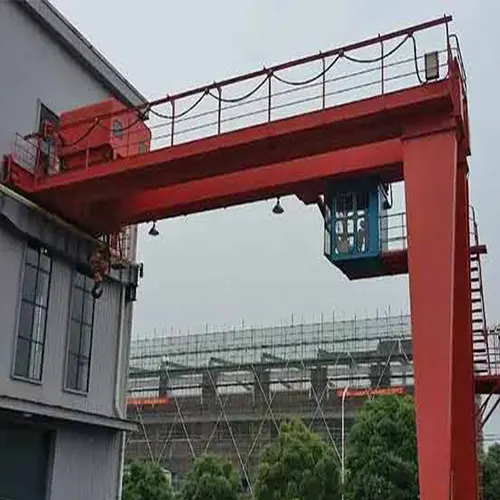
- Description: A semi-gantry crane is a hybrid design where one side of the crane runs on a runway at the ground level, while the other side runs on an elevated runway, typically on the side of a building or a structure. This configuration allows for efficient use of space while still providing robust lifting capabilities with the C-hook.
- Applications: Suitable for indoor and outdoor environments where space constraints or unique structural requirements exist, such as workshops, assembly lines, and maintenance facilities.
- Advantages: Space-saving design, cost-effective for environments with limited overhead space, flexible operation in constrained areas.

Truss Gantry Crane with C-Hook
- Description: The truss gantry crane features a truss structure, which is lighter and often used in environments where wind load considerations are critical. The truss design allows the crane to handle substantial loads with reduced weight and is typically used for longer spans.
- Applications: Commonly found in outdoor environments, such as construction sites, large storage yards, and ports, where wind resistance and load handling are crucial.
- Advantages: Lightweight yet strong, excellent wind resistance, ideal for long spans and outdoor applications.
C-Hook gantry cranes come in various configurations, each tailored to specific industrial needs and load-handling requirements. From the compact and versatile single girder goliath gantry crane to the robust and heavy-duty double girder variant, each type offers unique advantages depending on the operational environment and load specifications.
Applications and Industries
Steel Mills and Metal Processing: Gantry C-Hook Cranes are essential in steel mills and metal processing plants, where they handle large, heavy, and irregularly shaped loads like steel coils, slabs, and billets. The C-Hook's design allows it to securely grip these cylindrical or flat materials, making it easier to move them through different stages of production. These cranes are often used to transport raw materials from storage to processing lines, transfer semi-finished products between workstations, and load finished goods onto trucks or railcars for distribution.
Warehousing and Logistics: In warehousing and logistics, Gantry C-Hook Cranes provide a versatile solution for handling large and bulky items that cannot be easily managed with standard forklifts or pallet jacks. They are commonly used to lift and move heavy materials such as large rolls of paper, cable drums, and bulky construction materials. The mobility of gantry cranes makes them ideal for use in large storage yards or distribution centers, where they can be relocated as needed to optimize workflow and space utilization.
Manufacturing and Assembly Lines: Gantry C-Hook Cranes play a crucial role in manufacturing and assembly lines, particularly in industries where large components need to be moved with precision. They are often employed in the production of heavy machinery, automotive parts, and industrial equipment. These cranes facilitate the smooth transfer of components between different stages of the assembly process, reducing downtime and improving efficiency. The ability to customize the height and width of the gantry crane allows it to be tailored to specific assembly line configurations, ensuring seamless integration with existing processes.
Customization and Features
Automated vs. Manual Controls: Gantry C-Hook Cranes can be equipped with either automated or manual control systems, depending on the needs of the operation. Automated controls, often integrated with advanced sensors and software, allow for precise, consistent handling of loads, reducing the risk of human error and increasing overall efficiency. These systems can be programmed to perform repetitive tasks, such as loading and unloading materials, with minimal supervision. On the other hand, manual controls provide operators with direct, real-time control over the crane's movements, making them ideal for tasks that require a high degree of flexibility and human judgment. The choice between automated and manual controls depends on factors such as the complexity of the tasks, the level of precision required, and the available budget.
Safety Enhancements: Safety is a paramount concern in the operation of Gantry C-Hook Cranes, especially when handling heavy and bulky loads. Modern gantry cranes are equipped with a range of safety features designed to protect both the operator and the equipment. These may include overload protection systems that prevent the crane from lifting loads beyond its rated capacity, anti-sway technology that stabilizes the load during movement, and emergency stop mechanisms that allow for immediate cessation of operations in case of an unexpected issue. Additionally, safety sensors can be installed to detect obstacles or personnel in the crane's path, automatically halting the crane's movement to prevent accidents. These enhancements ensure that the crane operates safely and reliably, even in challenging industrial environments.
Installation and Maintenance
Installation Guidelines: Installing a C-Hook gantry crane requires careful planning and execution to ensure optimal performance and safety. The process begins with a thorough site assessment to determine the best location for the crane, considering factors such as load paths, space constraints, and proximity to other equipment. Once the location is finalized, the foundation must be prepared to support the crane's weight and the loads it will handle. This may involve pouring concrete footings or anchoring the crane to existing structures. The crane's components, including the C-Hook, gantry structure, and control systems, are then assembled on-site, following the manufacturer's specifications. Precision alignment of the crane's rails and wheels is crucial to ensure smooth and stable operation. After installation, the crane must undergo a series of load tests and safety checks to verify that it meets all operational and safety standards before being put into service.
Routine Maintenance Practices: Regular maintenance is essential to keep Gantry C-Hook Cranes operating efficiently and safely. Routine inspections should be conducted to check for signs of wear and tear, such as cracks in the gantry structure, frayed cables, or worn-out bearings. Lubrication of moving parts, such as wheels, pulleys, and the C-Hook mechanism, is necessary to prevent friction and ensure smooth operation. Electrical components, including control systems and wiring, should be inspected for any signs of corrosion or damage. Any issues detected during these inspections should be addressed promptly to prevent more significant problems. Additionally, load testing should be conducted periodically to confirm that the crane can safely lift its rated capacity. Keeping detailed maintenance records helps track the crane's condition over time and ensures that all necessary repairs and upgrades are completed on schedule.
Common Issues and Troubleshooting: Despite regular maintenance, Gantry C-Hook Cranes may occasionally encounter operational issues. Common problems include misalignment of the crane's wheels, which can cause uneven movement and increased wear on the rails. This can often be resolved by realigning the wheels and checking for obstructions on the rails. Another common issue is the malfunctioning of the control system, which may result from electrical faults or software glitches. Troubleshooting this issue involves inspecting the wiring, testing the control panel, and, if necessary, resetting or reprogramming the system. The C-Hook itself may experience difficulties in gripping loads securely, which could be due to wear on the hook or improper adjustment of the gripping mechanism. Regular calibration and timely replacement of worn parts can prevent such issues. In cases where problems persist, consulting with the crane manufacturer or a professional service provider is recommended to avoid downtime and ensure the crane's continued safe operation.
Case Studies and Real-world Applications
Examples of Successful Implementations: Gantry C-Hook Cranes have been successfully implemented in various industries, providing efficient and reliable load handling solutions. For instance, in a steel mill, a 50-ton C-Hook gantry crane was installed to handle large steel coils, significantly improving the speed and accuracy of material movement between production stages. The crane's ability to adjust its height and width allowed it to navigate the narrow aisles of the mill while maintaining stability and control over the heavy loads. In another case, a logistics company used a 20-ton C-Hook gantry crane in its distribution center to handle bulky construction materials. The crane's mobility and precision control system reduced the time required to load and unload trucks, increasing the overall throughput of the facility.
Performance Metrics and Benefits: The performance of Gantry C-Hook Cranes is often measured by their load handling capacity, operational efficiency, and safety record. Key metrics include the number of lifts per hour, the accuracy of load placement, and the downtime due to maintenance or repairs. Successful implementations typically show a significant reduction in manual handling, leading to lower labor costs and fewer workplace injuries. Additionally, the use of Gantry C-Hook Cranes often results in faster turnaround times for loading and unloading operations, increasing overall productivity. The ability to customize the crane's features, such as adjustable heights and automated controls, further enhances its versatility and effectiveness in various industrial settings. Overall, Gantry C-Hook Cranes provide a robust solution for handling heavy and bulky loads, offering substantial benefits in terms of efficiency, safety, and cost-effectiveness.
Safety and Compliance
Safety Standards and Regulations: Gantry C-Hook Cranes must comply with stringent safety standards and regulations to ensure safe operation in industrial environments. These standards are set by organizations such as the Occupational Safety and Health Administration (OSHA) in the United States, the European Committee for Standardization (CEN) in Europe, and various national standards bodies worldwide. Compliance with these standards involves adhering to guidelines on crane design, construction, and operation, including load testing, inspection frequencies, and operator training. For instance, cranes must be equipped with fail-safe mechanisms to prevent accidental dropping of loads, and regular load tests must be conducted to verify the crane's lifting capacity. Additionally, safety signage and warning systems are required to alert operators and workers of potential hazards. Ensuring compliance with these regulations not only enhances safety but also reduces the risk of legal liabilities and operational shutdowns due to safety violations.
Safety Features and Best Practices: Gantry C-Hook Cranes are designed with various safety features to protect operators and workers. These include overload protection systems that prevent the crane from lifting loads beyond its rated capacity, emergency stop buttons that immediately halt all crane movements, and anti-collision systems that avoid collisions with other equipment or structures. The C-Hook itself is often equipped with secure locking mechanisms to ensure a firm grip on the load during lifting and transport. In addition to these features, best practices in crane operation involve regular safety training for operators, including instruction on the proper use of controls, awareness of load limits, and procedures for responding to emergencies. Routine inspections and maintenance are also critical to identifying and addressing potential safety issues before they lead to accidents. Implementing these safety features and practices helps create a safer working environment and reduces the risk of accidents and injuries associated with crane operations.
Comparative Analysis
Overhead C Hook Cranes vs. Gantry C-Hook Cranes
Key Differences and Advantages: Overhead C Hook Cranes and Gantry C-Hook Cranes are both essential for handling heavy and bulky loads, but they differ in design, functionality, and ideal applications.
- Mobility: Overhead cranes are typically fixed installations, offering extensive coverage within a building, especially for high bay facilities. In contrast, gantry cranes are mobile, often equipped with wheels or tracks, making them ideal for outdoor use or in areas where overhead structures cannot be installed. Gantry cranes can be relocated as needed, providing flexibility in changing work environments.
- Structural Requirements: Overhead cranes require substantial structural support from the building, which may necessitate significant modifications or reinforcements. Gantry cranes, however, are self-supporting and do not rely on building structures, making them a more viable option for temporary or leased facilities where permanent alterations are not feasible.
- Load Handling: Overhead cranes are better suited for high-capacity lifting, often handling loads up to 100 tons or more with great precision. Gantry cranes, while also capable of handling heavy loads (typically ranging from 5 to 50 tons), excel in applications that require horizontal movement across open spaces or where vertical clearance is limited.
- Work Environment: Overhead cranes are commonly used in controlled indoor environments, such as manufacturing plants and warehouses, where they can operate without interference from weather conditions. Gantry cranes, on the other hand, are designed to withstand outdoor environments, including exposure to wind, rain, and other elements, making them suitable for shipyards, construction sites, and other open-air operations.
Selection Criteria for Different Applications: When choosing between Overhead C Hook Cranes and Gantry C-Hook Cranes, several factors must be considered:
- Application Environment: If the operation is indoors with a fixed layout, an overhead crane may be preferable for its high lifting capacity and coverage. For outdoor or variable work environments, a gantry crane's mobility and adaptability may be more advantageous.
- Load Characteristics: For extremely heavy or complex loads that require precise vertical lifting, an overhead crane is likely the better choice. Gantry cranes are more suited for operations where the load needs to be moved over a larger horizontal area or where the infrastructure does not support an overhead system.
- Space and Structural Constraints: In facilities with limited headroom or where structural modifications are impractical, a gantry crane provides a flexible and often less invasive solution.
- Budget Considerations: The cost of installation and structural modifications for overhead cranes can be significant, while gantry cranes might offer a more cost-effective solution, especially in temporary or changing environments.
Cost-Benefit Analysis
Cost of Implementation and Operation: The initial cost of implementing a C-Hook overhead crane generally includes not only the crane itself but also the necessary structural reinforcements to the building, installation, and operator training. This can make overhead cranes a significant investment. On the other hand, gantry cranes typically have lower upfront costs since they are self-supporting and require minimal modifications to the existing infrastructure.
In terms of operation, overhead cranes can be more cost-effective in the long run for high-volume operations, as they are designed for continuous, heavy-duty use with minimal downtime. Gantry cranes may incur additional costs related to mobility and outdoor operation, such as maintenance of tracks or wheels and dealing with environmental wear and tear.
Return on Investment and Efficiency Gains: Overhead cranes often provide a higher return on investment (ROI) in industries where precision and high-capacity lifting are critical. Their ability to handle complex, repetitive lifting tasks with high efficiency can lead to significant productivity gains, which can offset the higher initial costs over time.
Gantry cranes, while potentially offering lower immediate ROI due to their lower lifting capacities and higher maintenance in outdoor environments, shine in their versatility and adaptability. They provide a quick and flexible solution in industries with fluctuating demands or where the infrastructure does not justify a permanent overhead system. The ability to move and repurpose gantry cranes as needed can result in long-term efficiency gains, particularly in dynamic or expanding operations.
Overall, the choice between C-Hook overhead and gantry cranes should be guided by a thorough analysis of the specific operational needs, environmental conditions, and financial considerations, ensuring that the selected system offers the best balance of performance, cost, and long-term value.
Practical Considerations
Custom Solutions for Unique Requirements
Tailoring C-Hooks for Specific Applications: C-Hook cranes can be customized to meet the unique needs of different industrial applications. This customization involves modifying the C-Hook design to handle specific types of loads or to fit particular operational requirements. For instance, C-Hooks can be designed with specialized grips or clamps to securely hold non-standard load shapes, such as large rolls of paper or irregularly shaped metal components. Custom features may also include adjustable hooks or interchangeable attachments to accommodate varying load sizes and types. Collaborating with manufacturers to tailor these features ensures that the C-Hook crane performs optimally and safely for the intended application.
Handling Specialized Loads: For industries dealing with specialized loads, such as delicate or high-value items, C-Hook cranes can be equipped with load-specific accessories. For example, in the glass manufacturing industry, C-Hooks can be fitted with padded or cushioned grips to prevent damage to the glass. In the automotive sector, C-Hooks might be designed to handle engine blocks or chassis components, with custom designs that fit the specific dimensions and weight of these parts. Addressing these specific handling requirements through tailored C-Hook solutions enhances efficiency and minimizes the risk of damage to both the loads and the equipment.
Environmental Considerations
Corrosion Resistance and Environmental Protection: C-Hook cranes often operate in harsh environments where exposure to corrosive substances, such as chemicals, saltwater, or extreme temperatures, can impact their performance and longevity. To combat this, cranes can be constructed from corrosion-resistant materials or coated with protective finishes. For example, in marine environments, C-Hooks might be made from stainless steel or coated with anti-corrosion paint to prevent rust and degradation. Additionally, using weather-resistant components and seals can help protect the crane's mechanical and electrical systems from environmental damage.
Operating in Extreme Conditions: C-Hook cranes used in extreme conditions, such as high temperatures or freezing environments, require specific design considerations. In high-temperature environments, components may need to be made from heat-resistant materials or equipped with cooling systems to prevent overheating. Conversely, in cold environments, cranes might include heated components or use lubricants that remain effective at low temperatures. Proper insulation and protection of electrical systems are also crucial to ensure reliable operation and safety in these challenging conditions.
Integration with Other Systems
Coordinating with Automated Systems: Integrating C-Hook cranes with automated systems can significantly enhance operational efficiency. Automated systems, such as conveyor belts, robotic arms, or warehouse management software, can be synchronized with C-Hook cranes to streamline material handling processes. For instance, a C-Hook crane can be programmed to automatically lift and place loads onto a conveyor system based on real-time production data. This integration minimizes manual intervention, reduces errors, and speeds up operations.
Compatibility with Existing Equipment: When implementing a C-Hook crane in an existing facility, ensuring compatibility with current equipment is essential for smooth operation. This involves assessing the crane's integration with existing systems such as power supplies, control panels, and structural supports. Compatibility checks should include verifying that the crane's dimensions and operational range fit within the facility's layout and that it can interface effectively with other machinery. Proper planning and coordination during the installation phase help prevent disruptions and ensure that the new C-Hook crane complements existing operations seamlessly.
Conclusion
C-Hook cranes, whether overhead or gantry, play a crucial role in industrial environments by facilitating the efficient handling of heavy and bulky loads.
- Overhead C Hook Cranes: These are typically used for high-capacity lifting in indoor settings, offering advantages such as extensive coverage and high precision. They come in various configurations, including single and double girder designs, and can handle loads ranging from 10 to 100 tons. Key features include advanced control systems and customization options to suit specific load handling needs. Their design considerations, such as structural integrity and automation, contribute to their efficiency and safety in industrial operations.
- Gantry C-Hook Cranes: These cranes provide a flexible solution for both indoor and outdoor applications. They are self-supporting and mobile, making them ideal for environments where overhead structures are impractical. Gantry cranes typically handle loads between 5 and 50 tons and offer features such as adjustable heights and widths. They are well-suited for steel mills, warehouses, and manufacturing lines, with customization options that cater to diverse industrial requirements.
Each type of C-Hook crane has distinct advantages based on the operational environment and load handling needs. Understanding these differences helps in selecting the right crane for specific applications.
Final Considerations:Choosing the Right C-Hook Crane for Your Needs:
Selecting the appropriate C-Hook crane involves evaluating several factors to ensure it meets your specific requirements. Consider the following:
- Application Environment: Determine whether an overhead or gantry crane is better suited for your workspace. Overhead cranes are ideal for fixed, indoor installations with high lifting capacities, while gantry cranes offer mobility and flexibility for outdoor or temporary setups.
- Load Specifications: Assess the types and weights of loads to be handled. Overhead cranes can manage heavier loads with higher precision, while gantry cranes offer versatility for a range of load sizes and types.
- Space and Infrastructure: Review the available space and existing infrastructure to ensure compatibility with the crane's design and operational needs. Overhead cranes may require structural modifications, whereas gantry cranes provide a more adaptable solution without altering existing structures.
- Budget and Cost: Evaluate the initial investment and long-term operational costs. Overhead cranes might involve higher upfront costs due to structural requirements, while gantry cranes could offer a more cost-effective solution with flexible installation options.
Related Products
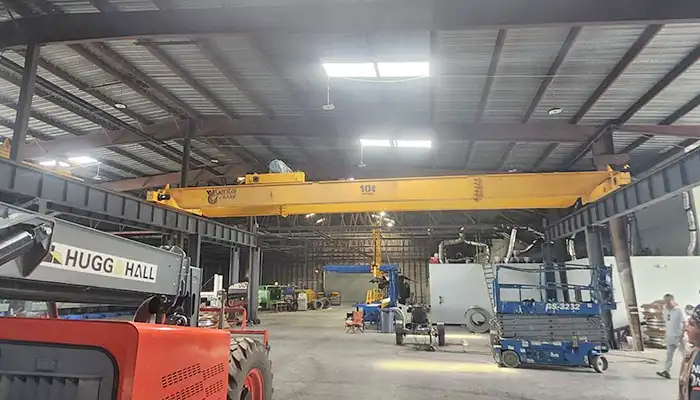
Affordable 10 ton double girder overhead crane with CD/MD hoist trolley, built for U.S. standards, ideal for construction and industrial lifting
Free consultation to Confirm Parameters & Specifications and Get
Latest Crane Price & Crane Rate.
- Types of overhead cranes : _______?
- Optional: Overhead travelling crane, goliath gantry crane,Slewing jib crane, Single girder or double girder crane,small portable crane or kbk crane, etc.
- Capacity of overhead crane: _______?
- Optional: 0.25ton, 0.5 ton, 1 ton, 2 ton, 3ton, 5 ton, 10 ton,15ton, 20ton, 25 ton, 30ton,35ton, up to 550ton, etc.
- Crane span & lifting height : _______?
- Crane travelling length : _____?
- Control of overhead crane:_______?
- Optional: pendant/ remote/cabin control
- Voltage supply of overhead crane:_____?
- Eg,: 380V50/60HZ,3Phase or others,etc.
- Application/usage of crane:_______?
- Eg,: Steel mill, ,injection mold, cement,stone, concrete,granite, general manufacturing, etc.
Just leave a message via the contact form and our hoist and crane engineer will contact you with in 24working hours.
Get In Touch
